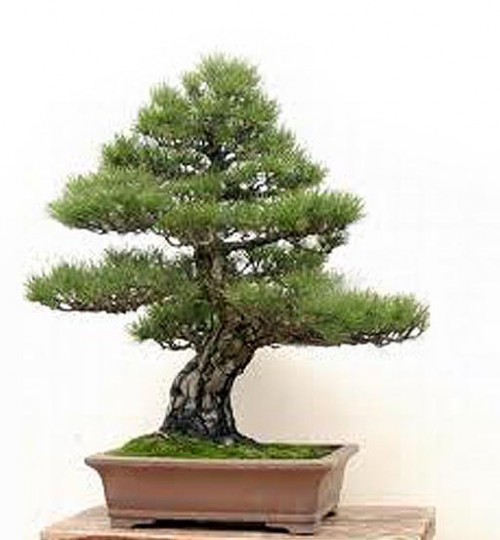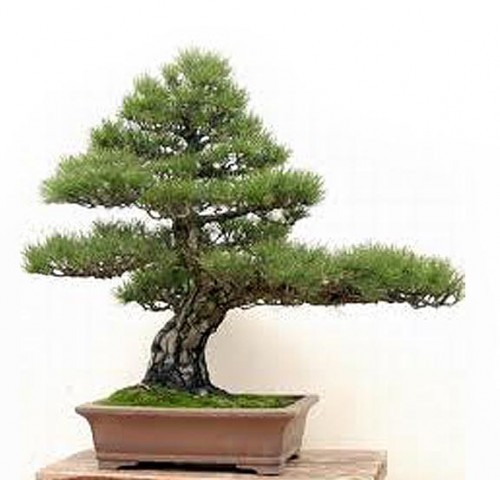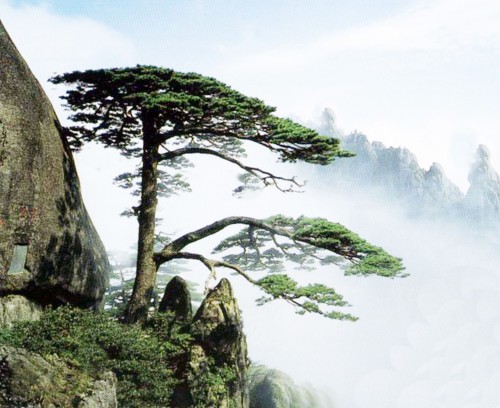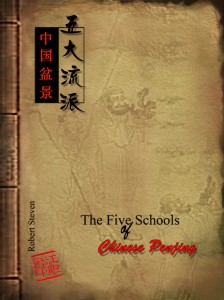
Robert Steven’s simulation of a Japanese black pine that was submitted by Mike Liu (Mike’s original is immediately below).

Mike’s original photo that was submitted to Robert.
Robert’s Critique
The Five Schools of Chinese Penjing
The above black pine bonsai is sent by Mike Liu from China. Since Chinese bonsai is called penjing, I will offer a brief discussion of penjing.
The main difference between penjing (Chinese: pen = pot; jing = panorama) and bonsai (Japanese: bon = pot; sai = plant), despite the terminology, penjing is more about artistic nuance in portraying natural phenomena; and bonsai is more disciplined in technical skill with the objective of suggesting the physical perfection of an old tree. Penjing is more symbolic as well as a media for the artist in expressing his emotional ideas. To a certain extent, bonsai is rather bounded within its convention and rules; where penjing is more free as personal expression.
As the above bonsai was created in China, I will give my critique from the Chinese penjing’s perspective; and at the same time, give readers better understanding about Chinese penjing, especially of the different schools.
Due to the climate difference, local species, culture, interest, habit, history, value of appreciation and other local aspects, there are many distinguish styles of Chinese penjing from one area to the other. But in general, they can be divided into five main schools: Lingnan (Lingnan Pai), Shuzhou (Shu Pai), Yangzhou (Yang Pai), Sichuan (Chuan Pai) and Shanghai (Hai Pai). Beside these, there are some other minor schools formed later as interest in penjing grew in China e.g. Nantong (Tong Pai), Zhejiang (Zhe Pai), Wei Pai etc. But these relatively new schools are not considered among the main schools because they have neither strong historical background nor obvious distinction in concept and style.
A school is formed when a certain distinguished style is identified and recognized as being practiced by followers in a certain area or community, and after having gone through a long processing period before being admired by the national penjing community. Some schools keep developing through refining the technical aspect without losing their specific characters and identity; but some are transforming as the consequence of global cultural interaction.
The above penjing (I use “penjing” in this context) is a mixture of Lingnan Pai and Yang Pai. Beside the famous “clip-and-grow” form, the other most distinguished character of Lingnan penjing is the long lower branch as seen on the above tree. But normally such a branch in Lingnan is not so straight and flat, but rather will show curving lines to suggest a flowing image.
Such straight and flat foliage pads are only found in Yangzhou (Yang Pai) penjing and are called “clouds”.
This branch in this penjing is quite disturbing. It looks unnatural without suggesting any morphological reason. Long one-sided branches on pines (in nature) are normally formed on trees that grow on high mountain sides where branches grow away from the mountain towards the sun light. These pinse normally will not have a rounded crown because the heavy snow will disturb the apical meristem to form a flatter apex, and force flatter pads on the dominant branches. Understanding plant physiology and morphology helps with bonsai design; you can read more about this in Mission of Transformation.
Another reason why this penjing does not look good can be explained by an aesthetic principle. The line and form of this flat straight branch is not integrated to the line and form of other physical elements, so it looks like it doesn’t belong to the same tree. For more on lack of consistency and unity you can read about about aesthetic principles in Vision of My Soul.

Typical shape of pines which grow on mountain sides in the Yellow Mountain in China
At the top of this post is my simulation without the long straight branch. This penjing is more of the Shanghai (Hai Pai) penjing which looks closer to what we understand as Japanese bonsai. The reason is that Shanghai was one of the first cities in China with more contact and interaction with the outside world and more influenced by foreign cultures including bonsai and other art forms.

There’s lots to talk about Chinese penjing. My third book The Five Schools of Chinese Penjing is in the works. It will describe all aspect of each schools, the history, concept, technique and styles.
General comments
There is more than one way to design any bonsai and my critiques and recommended solutions might not always fit your taste because of personal preferences. But I always try to give my opinion based on artistic and horticultural principles.
To understand my concepts better, please read my books Vision of My Soul and Mission of Transformation which are available at Stone Lantern.
You can also visit my bonsai blog.
That’s very illuminating about the various schools of penjing and the approach that separates it from bonsai.
I wonder, though, if any bonsai teacher in the US were brought that tree by one of his or her students, if the teacher would say, “That’s not a bonsai; that’s a penjing.”
Other than the “how you get there” and the level of perfection the tree currently exhibits, is there anything to distinguish penjing from Bonsai?
If so, I wonder how many of my trees would be considered penjing rather than bonsai.
Hey Al,
I’m beginning to feel like we’re old friends.
And yes, in this case I can’t tell the dif between bonsai and penjing. In fact, had I not known I would say this tree is a Japanese (or Japanese influenced) bonsai.
There are however, many trees and particularly landscape plantings that clearly have a distinct penjing flavor.
‘Penjing’ or ‘Bonsai’? Very much a Japanese influence tree in this discussion; as Robert had pointed out though that even though the tree was of the Yang Pai School, influenced by the extremes of growth observed in high mountain trees, with removal/reduction of the first branch, it becomes a tree mire of the Hai Pai School … where Robert points out that this (Shanghai) school is very much influenced by Japanese styling.
Looking forward to Robert’s third book … with greater understanding we are able to share internationally our art, science and philosophy.
Thanks Andrew,
Yes. The tree in question is pretty much indistinguishable from Japanese bonsai, which is not the case with most penjing, which seems to have stuck to a more distinctively Chinese feel. It’s interesting that, except in the early stages (1,000 years or so ago) of commerce and cultural movement from China to Japan, how little Japanese bonsai has been influenced by penjing. The exception might be bunjin (literati) style, which I believe came from a much later period when there was some fascination in Japan with the arts (particularly calligraphy) of the Chinese literati. I suspect the saikei may have also been influenced by penjing.
This is a very nice blog where I can learn a lot
I’ve only visited from the bonsai
Just took another look at the tree. There are a couple things that distinguish it from a Japanese bonsai: The branching isn’t as systematic (first branch one side, second branch the other side or back and so forth) as you’d expect, and the tree isn’t as refined as most noteworthy Japanese bonsai are.
Thank you Henk. Feel free to visit whenever the spirit moves you.
I sure hope this book is of a higher quality then the last. The Mission… book was terrible.
Hi Dennis,
I respectfully disagree.
Wayne. Is it just my copy then? Color reproductions are below acceptable. Light gray text that is very difficult to read. Maybe I got a bad copy.
Aha. You are talking about the quality of the production of the book. Looks like you got defective copy. There were a few. We can send you a replacement if you send us your address. Best of all is with your next order (that way we save on shipping), but either way.
Al, as I mentioned on my first book, one commented my creation as contaminated bonsai and unauthentic penjing. In my opinion, arts are living things and always interacting bwtween different cultures. No matter you call it bonsai or penjing, you make it look like bonsai or penjing, the most important is to follow the basic phylosophy, to implement the concept and principles; and in this context, the advice of John Naka still relevant..make them look like a tree.
In my case, I try to combine the technical aspect of “bonsai” with the inner beauty of penjing, so you can call wathever you like…
And for my third book “The Five Schools of Chinese Penjing”, I don’t mean to clasification nor black-and white difference between bonsai and penjing, but simply for our better understanding about this art form..because even in China nowadays, schools is no more the issue, harder and harder we can tell the difference due to the globalization, except certain distinctive characteristic like the Lingnan.
Wayne, I certainly agree with you that Saikei and Bonkei are influenced by penjing? but literati style was first practiced in China in Tang Dynasty which was called ”Wen ren shu“ ?you can read this in my first book “Vision of My Soul”?
You are right that many people misinterprate every panoramic or certain grouping bonsai as penjing? however? there are certain styles are quite identical to as penjing because not many ”Japanese bonsai“ practitioners do it? eg? windswept? certain raft style? combination with rock or figurines? mother-and-son style etc?
Too much to talk about penjing?????
Thanks Robert,
Yes, I agree about when bunjin originated in China. What I was trying to say was that interest in bunjin in Japan came later. “I believe came from a much later period when there was some fascination in Japan with the arts (particularly calligraphy) of the Chinese literati.” If memory serves, I think this revival of Japanese interest in Chinese arts took place in the 19th century. However, my knowledge (and memory) takes a distant back seat to yours in these areas and I always welcome your insights, especially when we can share them with our readers.
Yes, once again I agree with Robert. As the world get smaller, old classifications are breaking down. The cross pollination and blurring of styles seems to be pushing the art of bonsai forward rapidly.
Robert You are a genius. A plant that looks ho hum gets transformed such that it looks as if its going to step out of the pot and float towards you. Did You come to Lucknow in 2208. I wish I knew then. I live in Lucknow (India) I would have met you and learnt from you. Do tell me if you plan to come again… Can I send you some pictures of my creations and request your help in styling them better?
Thanks Devika,
I’ll forward your comment to Robert.
Thanks Devika.
I think I was in Lucknow in 2003 and in Delhi in 2005.
You can send your bonsai to bonsaibark for my critique.
Hope to meet you sometimes…
Thanks Robert. I shall send you some pictures of my very very amateur creations. I am a medical doctor by profession by an avid gardener by passion. You have been to Lucknow and would perhaps agree that successful gardening specially of Bonsai is an uphill task given the wide variation in temperature. Very hot and dry summers and cold dry winters. With deluge of rain in monsoon season. This limits the choice of species that can be successfully bonsaied. However my tenacity has not failed and I am still at it. I lose a lot of plants but I will not give up. I love saikeis because you don’t have to wait ages for it to become interesting.Of bonsai material I think Premna should do well as well as Bougainvillea
I shall be visiting my daughter in the UK for a month. I do wish to visit some nurseries near London.Any suggestions. Peter Chan,s is the one I know I should visit.
I shall soon by forwarding you some photos of my plants which to my mind have some bonsai potential. I suppose view from all sides as well as top should be OK
Thank you Robert for taking the time to reply to my post.
I visited your facebook page too. You have lovely photos there
Take care
Devika